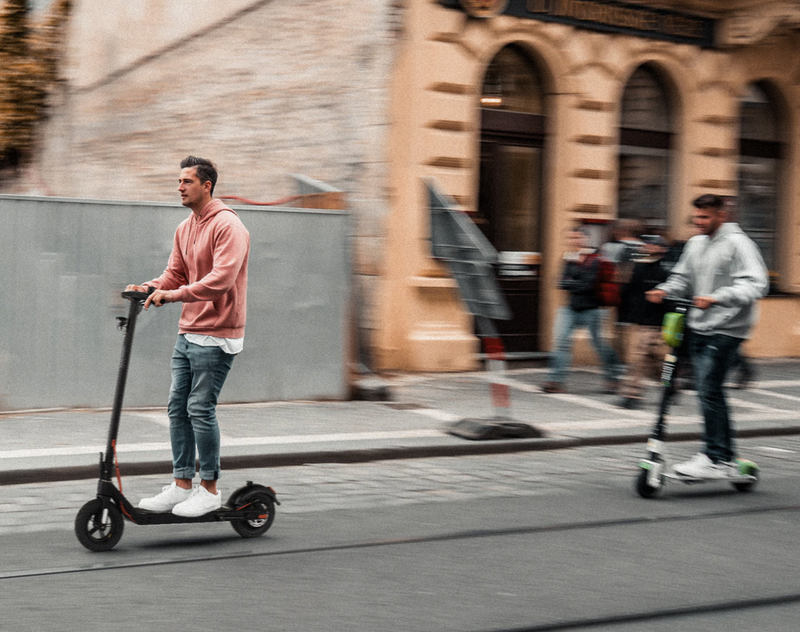Have you ever wanted to go for a ride only to discover a problem, the electric scooter motor not running? This can be frustrating, right? While electric scooters are sturdy and built to last with little maintenance, some components may sustain issues or damage over time.
These issues, which include melting, burning, or malfunctioning of some parts, arise mainly because of excessive use, charge, or stress from riding in adverse conditions. Whichever it is can spoil your planned activities for the day, which is why you should have some knowledge on how to fix it. We've highlighted some tips on how to fix electric scooters not running.

Part 1. How Does an Electric Scooter Motor Work?
Electric scooter motors may come in varying kinds, for example, the electric motor and hub motor. These motor types are generally fixed to the front or rear wheel but do not change the design or structure of the scooter. Besides they are easily installable and situated in a spot with easy access for repairs or servicing.
The motor is the working mechanism of an electric scooter and works in a fascinating way. It transmits power through a shaft to the scooter's wheels, giving it that moving ability. However, as the hub delivers power to the scooter to aid locomotion, it wears out and requires maintenance.
Good knowledge of the motor types your scooter has will enhance your proactive usage and maintenance of the scooter. Without constant maintenance of mechanical devices like the hub motor, the electric scooter may not move. The electric scooter hub motors may come in differing designs, and they include:
- Gearless Hub Motors – These types are mostly large and more efficient than geared hub motors because they transmit enormous power and rotation to the electric scooter.
- Geared Hub Motors – the geared hubs are usually less powerful, small, and lightweight even though they afford the scooter a better range.
- Brushed Motors – are sturdy and durable, with an amazing ability to withstand higher driving pressure. However, they are less powerful and efficient and have more moving parts than brushless hub motors. The brushless ones are unreliable in adverse situations but transmit more power and torque to the scooter.

Part 2. If the Electric Scooter Motor Runs but the E-scooter Doesn't Move
If you don't know how to repair an electric scooter motor, you can spend many hours without finding out the issue with your scooter. You can try to rectify the damage if, for instance, the scooter motor runs and the scooter doesn't move. Here are troubleshooting tips to help it fix.
1. Run a Check on the Power Transmission System
Compound gear trains (also known as simple gear trains) and bevel gear differentials are the two main components of an electric scooter's transmission system. The former has a considerable impact on both efficiency and noise level. Thus, you should check whether the gear parts are worn out and need replacement. Also, you should check that the gear trains are still in top-notch condition.
2. Install The Belt Or E-Scooter Chain Properly
Sometimes the scooter doesn't move because the chain or belt is not properly fixed. Here is a detailed guide on how to fix the belt.
Trace the belt to the motor's "drive" pulley. To remove the drive belt, push the inner portion of the pulley against the motor. Completely remove the belt from the pulleys.
Pull the driven pulley's two halves open, then slide the new drive belt in between them. When the belt is set against the bottom of the pulley halves, rock the belt into position to secure it.
The drive belt free end should be pulled overdrive and placed in the middle of the pulley halves. Ensure that the belt moves freely in the pulley by pulling with your hand. Afterward, switch on the ignition to tighten the drive belt.
3. If the rear wheel doesn't move but the motor and chain/belt run
If the motor is fine and the rear wheel doesn't run, then it's most likely that the CVT belt system is faulty. This can also be due to the gears connected to the back tire not getting enough power, possibly leading to a jammed wheel. In this case, you need to replace the belt if it's worn and not generating enough power to spin the wheel.
4. The rear wheel and chain/belt don't spin, but the motor is working fine
The motor is fine, but the chain or belt and the rear wheel don't spin. This may be due to the belt getting old, overused, or worn out. It may also be due to broken gear teeth, rendering the wheels immovable. You need to replace the gear teeth and oil them properly; also, get a new belt to enable the smooth spin of the rear wheel.

Part 3. If the Electric Scooter Motor Doesn’t Run
Whether your E-scooter features a brushless motor or other types, it needs routine and proper maintenance and repairs to ensure optimal performance. The motor could be one or two, depending on its performance level. It handles its speed, torque, and general performance.
So, if it stops running, this can be frustrating and hinder your movement. What do you do? Here is how to repair an electric scooter motor.
1. Push the E-scooter to start
This applies if your e-scooter is a kick-start model. Place one foot on the footplate and the other on the ground, then push a short distance to start the motor. If this doesn't make the electric scooter motor work, try the next method.
2. Check the Motor
The first thing to do when your e-scooter doesn’t run, or the motor runs slowly is to check the motor. You should ensure you charge your e-scooter and switch it off before opening the electric compartment to avoid shocks.
In modern e-scooters, the manufacturers place the motor in the front or rear wheel hub. It's important to look out for humidity and overheating.
Humidity: Since e-scooters are not waterproof, there will always be a risk of vulnerability to water damage. Humidity can contribute to the corrosion of motor parts. You should look out for corrosion or moisture in the motor. If the level of moisture is low, you can wipe it away and put it in a warm, dry place for the moisture to evaporate.
If the motor does not run after this or the moisture content is high, contact a professional for repairs.
Overheating: The signs include:
- The motor struggles to start
- A hot battery
- A strange smell came out of the motor compartment,
- E-scooter is hot to the touch
- The indicator light on the battery charger turns orange or red
The causes are:
- A damaged battery pack
- A wiring fault
- Poor ventilation in the motor compartment
- Hot weather
- Excessive or careless use of the scooter

3. Look for Any Burned Wires and Components
The key sign of a burned wire will be its giveaway smell. Look out for the smell of burning rubber. In most cases, a burned motor component will need replacement. You can contact a reputable e-scooter shop for any replacement parts.
4. Examine Any Loose Cables
To check for a loose cable or wire, you can gently tug on them. Put back any wire from its compartment and tighten the loose ones. Also, all the wires in a cable should be intact.
You can check this by using an electronic measuring device, preferably a multimeter.
5. Check the Battery and Charger
The electric scooter battery, charging port, or charger could be faulty. If your e-scooter has a charging indicator light, plug it in and watch the indicator light to see if it comes on or not. If it comes on, this means all three components work well.
Where there is no indicator light, use a multimeter to check the battery, then check it again while it is charging to check for an increase in voltage. An increase in voltage signifies that it is working well.
If there is no increase in voltage, you might need to replace the charger. If the battery loses power quickly and stops running for as long as it used to, you will have to replace the battery with a new one made for your e-scooter.
6. Test the Brake Lever
When the brake lever is engaged, it switches off acceleration automatically. If the lever wears out, it will lock the speed controller in place.
E-scooters have either an open brake lever or a closed brake lever.
To check if the open brake lever is faulty, open the motor compartment and locate the breaker. Then disconnect it from the controller. If you have a closed brake lever, after disconnecting the brake lever, connect the two terminals where you unplugged the brake lever.
If the lever is faulty, the motor will run, but if it’s not, it will not.
7. Test the Throttle
The throttle regulates how much energy the battery transfers to the motor. A loose wire could easily disrupt this energy flow, so tighten any loose wire.
Overheating could also melt the wires. Check for any burned wires. You can use an external source of no more than 5 volts DC to check if it’s working on its own. A working throttle will have a power output of 0.8 - 4.3 Volts DC. This can be measured with a multimeter.
The wires on a throttle are red and black, and the signal wire, which could be blue, green, or white. You should attach the power source to the red wire (+) and the black wire (-). Attach the multimeter to the black wire (-) and the signal wire.
The throttle is faulty if there is any burn or it doesn’t work with the external power source.
8. Inspect the Speed Controller
The speed controller is made up of several components. You should test each of the components to ensure they’re functioning. If one or more components are faulty, you should replace the speed controller.

- V8 Dual-Battery Long Range Electric Scooter
- Powerful motor delivers good performance on even surfaces and hilly areas.
- Two batteries double the range and allow an uninterrupted range.
- The longer range meets various needs from commuting to exploration.
- Riders can avoid traffic while making the commute fun and enjoyable.
- The aired tubes smooth bumps on the road and make every ride comfortable.
- Two springs are installed in the back to make rides more comfortable and stable.
Conclusion
Maintaining your e-scooter is very important to curb unnecessary wear and tear. Ensure to carry out maintenance periodically with the help of a professional. If the electric motor not running despite this, following the troubleshooting tips will greatly help out.
We, however, recommend that you take your e-scooter back to the manufacturer if it is still under warranty. If the warranty has expired, take it to an e-scooter repair professional to fix the faults.























